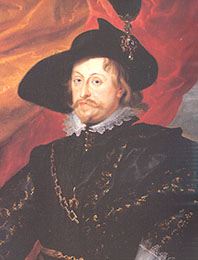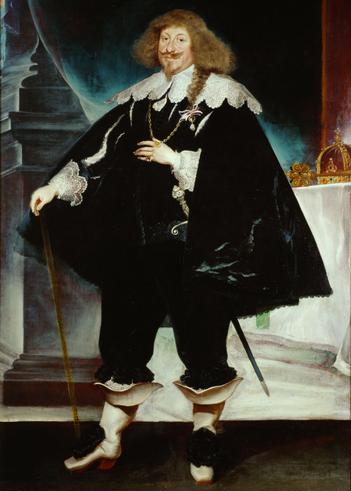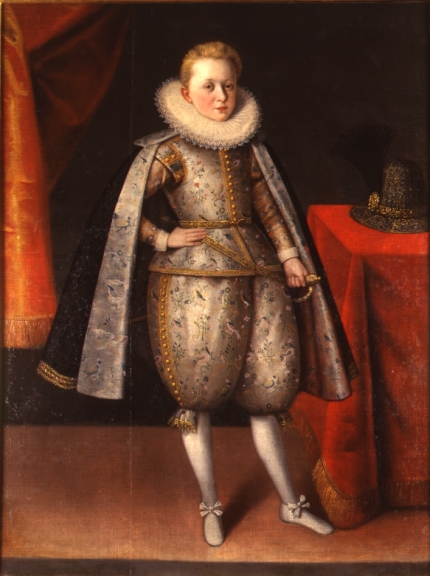<Back to Index>
- Classical Scholar Daniel Heinsius, 1580
- Painter Michael Peter Ancher, 1849
- King of Poland Władysław IV Vasa, 1595
PAGE SPONSOR



Ladislaus IV Vasa (Polish: Władysław IV) (June 9, 1595 – May 20, 1648) was a Polish and Swedish prince, the son of Sigismund III Vasa and his wife, Anna of Austria (also known as Anna of Habsburg). Władysław IV reigned as King of the Polish - Lithuanian Commonwealth from November 8, 1632, to his death in 1648.
In 1610, the teenage Władysław was elected Tsar of Russia by Seven Boyars, but did not assume the Muscovite throne due to his father's opposition and popular uprising in Russia; he used the title of Grand Duke of Muscovy until 1634. The throne during this time was instead held by Michael Romanov. Władysław managed to prevent the Commonwealth becoming embroiled in the bloody Thirty Years' War that ravaged western Europe during his reign, and was fairly successful in defending the Commonwealth from invasion. He supported religious tolerance and carried out military reforms. He failed, however, to realize his dreams of fame and conquest, or to reform and strengthen the Commonwealth. His death marked the end of the Golden Age of the Commonwealth, as conflicts and tensions that Władysław had failed to resolve led in 1648 to the greatest of the Cossack uprisings — the Khmelnytsky Uprising — and to Swedish invasion ("The Deluge").
As Władysław Zygmunt Waza - Jagiellon, in 1632 he was elected King of Poland. By paternal inheritance, he legally succeeded as King of Sweden. He was also heir to one of the several Christian claims to the title of King of Jerusalem, but the Kingdom of Jerusalem had been defunct for several centuries. His titles were the longest of those of any Polish king ever. His father Sigismund III Vasa, grandson of Gustav I of Sweden, had succeeded his father to the Swedish throne in 1592, only to be deposed in 1599 by his uncle, subsequently Charles IX of Sweden. This led to a long standing feud where the Polish kings of the House of Vasa claimed the Swedish throne. The effects of this were the Swedish War (1600 – 1629) and later, The Deluge of 1655. Sigismund, a devout Catholic, pursued other military conflicts abroad, barely avoiding involving the Commonwealth in the Thirty Year War and supported counter reformation, both policies which lead to increasing tensions inside the Commonwealth.
Władysław's mother died three years after giving birth to him. He would be raised by one of her former ladies of the court, Urszula Meierin. Urszula was a powerful player at the royal court, with much influence. Around early 17th century she seems to have lost much of her influence, as Władysław gained new teachers and mentors, such as priests Gabriel Prowancjusz, Andrzej Szołdrski and Marek Łętkowski. Władysław also formed a friendship with Adam Kazanowski and his brother, Stanisław. It is reported that Władysław was interested in arts; later this would lead to him becoming an important patron of arts. He spoke and wrote in German, Italian and Latin. Władysław was liked by szlachta, however, his father's plans to secure him the throne of Poland (vivente rege) were crushed in the Zebrzydowski Rebellion (rokosz).
In 1610 Władysław, aged 15, was elected Tsar by Muscovy's aristocracy council of Seven boyars, who overthrew tsar Vasily Shuysky during the Polish - Muscovite War and Muscovy's Time of Troubles. His election was ruined by his father, Zygmunt, who aimed to convert Muscovy's population from Orthodox religion to Catholicism. Zygmunt refused to agree to the boyar's request to send prince Władysław to Moscow and his conversion to Orthodoxy. Instead, Zygmunt proposed that he should reign as a regent in Muscovy instead. This unrealistic proposal led to resumed hostilities. Władysław tried to regain the tsar's throne himself, organizing a campaign in 1616. Despite some military victories, he was unable to capture Moscow. Władysław was never able to reign in Russia; he held on to the title, without any real power, until 1634. Before
he was elected king of the Commonwealth, Władysław fought in many
campaigns, seeking personal glory. After his final campaign against the Russians in 1617 - 1618 (the end of Dymitriads), in 1619 he went to Silesia, looking for an opportunity to aid the Habsburgs in their struggle against the Czech Hussites in the Thirty Years' War. That opportunity never came, but from that point onward, Władysław would have a good relationship with George William, Elector of Brandenburg. The following year Władysław would take part in the second phase of the Polish – Ottoman War, a consequence of the long series of struggles between Poland and the Ottomans over Moldavia. In 1621 Władysław would be one of the Polish commanders at the Battle of Chocim;
reportedly he was struck ill, but despite that, he proved a voice of
reason, convincing other Polish commanders there to stay and fight. His advice was correct, and the battle eventually ended with a peace treaty that returned the status quo from before the Ottoman invasion. This peace treaty also gave Władysław an international reputation as a "defender of Christian faith." In 1624 king Zygmunt decided that time has come for Władysław to travel, like many of his peers, to Western Europe. For security reasons, Władysław traveled under a fake name, Snopkowski (from Polish Snopek, meaning sheaf, as seen in the Vasa's coat of arms). In his voyage (1624 – 1625) he was accompanied by Albrycht Stanisław Radziwiłł and other, less notable courtiers. First, he travelled to Wrocław (Breslau), then Munich, where he met Maximilian I, Elector of Bavaria. In Brussels he met Infanta Isabella Clara Eugenia of Spain; in Antwerp, Rubens. Near Breda he met Ambrosio Spinola. It
was during his stay with Spinola that he was impressed by the Western
military techniques; this was later to be reflected when he became
king: military matters were always important to him. While not a military genius, and surpassed by famous Commonwealth contemporary hetmans like Stanisław Koniecpolski, Władysław was known as a fairly skillful commander on his own. In Rome, he was welcomed by Pope Urban VIII, who congratulated him on his fighting against the Ottomans. During his stay in Florence he was impressed by opera, and decided to bring this form of art to the Commonwealth, where it was previously unknown. In Genoa and Venice he was impressed by the local shipyards, which resulted in his later attempt to create the Polish - Lithuanian Commonwealth Navy. After returning to Poland, from 1626 to 1629 he would fight against the Swedes in the last phase of the Polish - Swedish War. At
first Władysław did not want to have deeper relationships with
the Habsburgs. In 1633 he promised the equal treatment of Protestants and orthodox
and forced Albrycht Stanisław Radziwiłł (Catholic) to countersign a decree by threatening him with giving key posts in the Commonwealth to Protestants. In 1633/35 he nominated Krzysztof Radziwiłł (Calvinist)
on the highest posts in the country (wojewoda wileński (of Vilnius –
capital of Lithuania), grand Lithuanian hetman). However after
Protestant nobles blocked his attempt to wage a war against Protestant
Sweden, in 1635 at the Armistice of Stuhmsdorf (Treaty of Sztumska Wieś), he renewed his father's alliance with the Habsburgs. Władysław IV owed allegiance to the Imperial Habsburgs as a member of the Order of the Golden Fleece. Władysław was married twice. At the very beginning of 1634, or even at the end of 1633 Władysław asked pope Urban VIII for
permission (or rather promise of permission, since no name was
included) to marry a Protestant princess. The pope refused, and the
speed of this refusal was treated by Władysław as an insult. At the
beginning of 1634
Władysław sent Aleksander Przypkowski with a secret mission to the king of England Charles I. The envoy had to discuss the king's marriage plans and ask for English help for
reconstruction of the Polish fleet. TThe King's marriage plans were discussed on
a Senate meeting on 19 March 1635, but only four bishops were present and
only one supported the plan. There exist also other documents concerning
the planned marriage of Wladislaw and Princess Elisabeth of Bohemia, Princess Palatine (daughter of Frederick V, Elector Palatine,
also known as the "Winter King"). However, when he was "cheated" during
the peace talks with Sweden in 1635 - by Polish magnates and nobles, many
of them Protestant, by Protestant Swedes and by Protestant
representatives of other foreign monarchs against a new war between the
Commonwealth and Sweden, a war Władysław pushed for - Władysław changed
his mind about marrying a Protestant and decided to seek support from
the Catholic factions, especially the Habsburgs. Another marriage briefly considered in 1636 was to Anna Wiśniowiecka, daughter of Michał Wiśniowiecki and sister of Jeremi Wiśniowiecki, of the powerful Polish magnate family of Wiśniowiecki. Although Władysław was quite supportive of the marriage, it was blocked by the Sejm. Anna eventually married Zbigniew Firlej between 1636 and 1638. Ferdinand II, Holy Roman Emperor's proposal of marriage between Wladislaw and Archduchess Cecilia Renata of Austria (sister of future Ferdinand III, Holy Roman Emperor) arrived in Warsaw somewhere during the spring of 1636. King's trusted, father Walerian (of Franciscan religious order) and voivode Kasper Doenhoff arrived in Regensburg (Polish: Ratyzbona) on 26 October 1636 with consent and started negotiations. The Archduchess dowry was agreed for 100,000 złoty (currency unit), the Emperor promised to pay dowries of Siegmund III both wives: Anna and Konstance. Additionally the son of Wladislaw and Cecilia Renata were to obtain the duchy of Opole and Racibórzin
Silesia (księstwo opolsko-raciborskie). However before everything was
confirmed and signed, Ferdinand II died and Ferdinand III backed down from
giving the Silesian duchy to the son of Wladislaw. Instead a dowry was
written/protected by the Bohemian estates of Třeboň (Trebon). The marriage took place in 1637. After Cecilia's death in 1644, he married the French princess Ludwika Maria Gonzaga de Nevers, daughter of Karol I Gonzaga, prince de Nevers in 1646. He had no heirs. He was succeeded by his half brother Jan II Kazimierz. Władysław was elected to
the Polish throne a few months after his father's death on 8 November
1632 and crowned on 5 February of the following year. In an attempt to
take advantage of the confusion expected after the death of the Polish king, Tsar Michael of Russia ordered an attack on the Commonwealth. A Muscovite army (of approximately
34,500) crossed the Commonwealth eastern frontier in October 1632 and
laid siege to Smolensk (which was ceded to Poland by Russia in 1618, at the end of the Dymitriad wars). In the war against Russia in 1632 - 1634 (the Smolensk War),
Władysław succeeded in breaking the siege in September 1633 and then in
turn surrounded the Russian army, which was then forced to surrender on
March 1, 1634. The resulting Peace of Polyanov (Treaty of Polanów), favourable to Poland, confirmed the pre-war territorial status quo. Muscovy also agreed to pay 20,000 rubles in
exchange for Wladyslaw's renunciation of all claims to the tsardom and
return of the royal insignia, which were in the Commonwealth possession
since the Dymitriads. It was during that campaign that Wladislaw
started the modernisation program of the Commonwealth army, emphasising the usage of modern infantry and artillery. Following the Smolensk campaign, the Commonwealth was threatened by another attack by the Ottoman Empire. During the wars against the Ottomans in 1633 - 1634 Władysław
moved the Commonwealth army south of the Muscovy border and forced the
Turks to come to terms with him. In the resulting treaty, both
countries agreed again to curb the border raids by Cossacks and the Tatars, to a shared joint suzerainty (a condominium) over Moldavia and Wallachia (Wołoszczyzna). After the southern campaign, the Commonwealth was threatened from the north. Sweden, weakened by its involvement in the Thirty Years' War, agreed to sign the Armistice of Stuhmsdorf (also known as Treaty of Sztumska Wieś) in 1635, favourable to the Commonwealth in terms of territorial concessions. The king, while Catholic, was very tolerant and didn't support the more aggressive policies of the Counter Reformation.
While it can be argued that he often played one religious movement
against
another as a means of conserving his own powers, it is a fact that he
was in effect one of the most tolerant monarchs of his time. Władysław was also a connoisseur of the arts and music. He sponsored many musicians and created the first amphitheater in the Warsaw castle, where during his reign dozens of operas and ballets were performed. He is credited with bringing the very genre of opera to Poland. He
also collected paintings and invested in decorative architecture; among
his most famous sponsored projects is the monument to his father, the Column of Sigismund which became one of the symbols of Warsaw and two palaces in the capital of Poland - Kazanowski Palace and Villa Regia. Władysław assembled an important collection of Italian and Flemish Baroque paintings, much of which were lost in the wars after his death. Notable artists Władysław supported included Tommaso Dolabella, Pieter Soutman, Peter Danckerts de Rij and Wilhelm Hondius. Wladislaw used the title of the King of Sweden,
although he had no control over Sweden whatsoever and never set foot in
that country. He would continue his attempts to regain the Swedish
throne, with similar lack of results as his father. Władysław was criticized for being thrifty; he lived lavishly, spending more than his royal court treasury could afford. He also dispensed much wealth among his courtiers, who were seen by people further from the court as mooching of the king. In internal politics he attempted to strengthen the power of the monarchy, but this was mostly thwarted by the szlachta, who valued their independence and democratic powers. Wladyslaw suffered continuing difficulties caused by the efforts of the Polish Sejm (parliament) to check the King's power and limit his dynastic ambitions. The
Szlachta viewed Vladislaus' military dreams as an attempt to strengthen
his position during war and thus the Sejm strongly
opposed the majority of his plans for war (for example, with Sweden in
1635 or the Turks in 1646), and usually thwarted them by denying the funds
for military campaigns and withholding its cosignature on the declaration of war.
Similarly, Wladislaw's foreign ambitions came to little, as his
attempts to mediate in the Thirty Year's War between the warring German
and Scandinavian powers came to nothing, and his support for the
Habsburgs brought him almost nothing in return. He attempted to create a Polish - Lithuanian Commonwealth Navy to secure part of the Baltic Sea,
but this plan never succeeded. Despite his support for religious
tolerance, he did fail, however, to resolve the conflict stemming from
the Union of Brest split. In
1638 Władysław proposed that the still unpaid dowries of his mother and
second wife of Zygmunt III would be protected by one of the Silesian duchies (preferably opolsko-raciborskie (of
Opole-Racibórz)). In 1642 he proposed to give Habsburgs his rights
to Swedish throne in exchange for giving him Silesia in deposit. Ludovico Fantoni, sent to Vienna in the summer of 1644, proposed to exchange Wladysław's incomes from the Bohemian estates in Treben for the duchies opolsko-raciborskie and cieszyńskie (of
Cieszyn (Teschen)). At the beginning of 1645, tired by constant
stalling of Vienna's court, Władysław announced to the Emperor's envoy sent to
Warsaw, Maximilian Dietrichstein,
that Poland will cooperate with Sweden – it was an open threat (that he
could take Silesia with the Swedes help and against the Emperor) pronounced by
the fact that on 6 March 1645 the Swedish general Lennart Torstensson defeated the Emperor's Bavarian and Saxon forces in the battle of Jankov and started a march against Vienna. Now the Emperor was again ready for negotiations and sent Johannes Putz von Adlertum to
Warsaw in April 1645 giving him wide prerogatives in transferring
the rights of the duchy opolsko-raciborskie to the son of Władysław and Cecylia
Renata, Zygmunt Kazimierz, as a hereditary fief. Negotiations eventually
ended in Habsburgs success and Polish failure. The duchy was given not as
a hereditary fief but as a 50 years long deposit and the owner was required to
swear allegiance to the king of Bohemia (thus it could not be a Polish king),
but as an exempt Władysław would rule the duchy until his son was an adult.
Additionally Władysław promised to lend the Emperor 1,100,000 złoty (minus the still unpaid three dowries). Many
historians argue that Wladislaus was very ambitious and dreamed of
achieving great fame through conquests, and in the latter years he
planned to use the Cossacks to provoke the Turks into attacking Poland
so that his military leadership would be indispensable. On various
times he set his sights on regaining the Swedish crown, capturing the
Russian throne and even conquering the entire Ottoman Empire. He was often able to convince the restless Cossacks to join his side, but with little support from the szlachta and foreign allies (like the Habsburgs),
he constantly failed in those attempts, often resulting in unnecessary
border wars and diluting the strength of the Commonwealth, which later
proved fatal when the country was finally invaded by its neighbours. Some
Polish historians claim that Wladislaus had short temper and when
angered, could act to take revenge without considering all
consequences. E.g. when the Protestant szlachta blocked his plans for war
with Sweden in 1635, he turned back to pro-Habsburg politics, sent them
military help and married the archduchess Cecylia Renata. He had many plans
(dynastic, personal, about wars, territorial gains: regaining Silesia,
Inflanty (Livonia), incorporation of Ducal Prussia, creation of his
hereditary dukedom etc.), some of them with real chances of success,
but because of bad luck or objective obstacles almost nothing went as
he planned.


